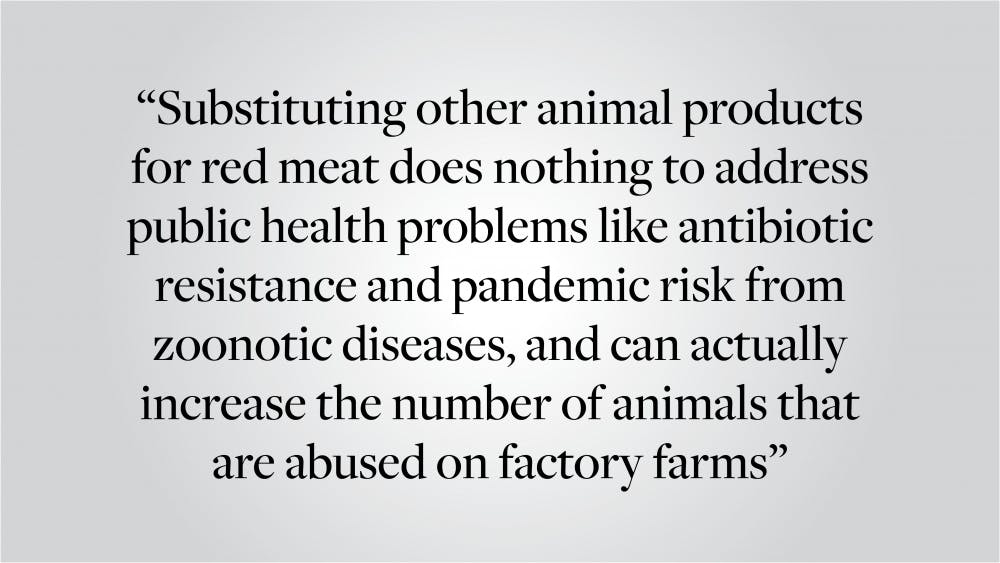The Undergraduate Council of Students noted in an April 30 email that Brown will charge a Red Meat Working Group with delivering recommendations for reducing red meat consumption on campus. The rationale stated in the Sustainability Strategic Plan for reducing red meat (i.e. beef and pork) is that it will lower the University’s contribution to nutrient pollution, which includes nitrogen- and phosphorus-laden waste products from agriculture that contribute to a variety of public health and environmental problems. Red meat purchases comprise one-fifth of Brown’s nitrogen footprint, so the plan aims to cut red meat consumption in dining halls by 25 percent by 2025 and perhaps 50 percent by 2030.
The fact that the plan is specific to red meat, and lacks an explicit commitment to reduce animal products as a whole, makes it insufficiently holistic. It is true that reducing red meat consumption alone may constitute “progress” by the narrow metrics of nutrient pollution and greenhouse gas emissions. However, the plan fails to specify what food items will replace red meat. Those tasked with implementing the plan should note that substituting other animal products for red meat does nothing to address public health problems like antibiotic resistance and pandemic risk from zoonotic diseases, and can actually increase the number of animals that are abused on factory farms.
The public health risks associated with animal products (and not just red meat) include some of the most pressing issues of the 21st century. For example, the poultry and farmed fish industries both contribute to the rising threat of antibiotic-resistant microbes in the same way that other meat production does: When antibiotics are used in meat production, natural selection yields bacterial strains that survive current medical treatments. The United Nations has estimated that by 2050, antibiotic resistance could kill 10 million people annually, which is more than twice the number of people who have died of COVID-19 as of June 2021. If such a disaster takes place, it may be due in large part to animal agriculture. Currently, 80 percent of antibiotics sold in the United States are used in animal agriculture, and of those, 70 percent are considered “medically important” by the Food and Drug Administration.
Furthermore, switching from red meat to chicken or turkey fails to address the pandemic risk animal agriculture poses. As the past year has shown, zoonotic diseases — such as the avian flu, commonly spread by chickens — pose a serious threat to humanity. In recent decades, epidemiologists have observed avian flu strains with mortality rates up to 60 percent. Luckily, such strains have so far not been contagious among humans, but scientists worry that mutations could arise that enable human-to-human transmission. Increasing our reliance on chicken for meat heightens the risk that such a mutated strain arises. If this happens, the effects of an ensuing pandemic could far exceed those of COVID-19.
Replacing beef and pork with other meat products is also counterproductive from an animal welfare standpoint. This is partly because chickens, turkey and fish are much smaller animals than pigs and cows, so a much larger number (100 times more chickens than cows) must be murdered in order to produce the same amount of meat. Over 99 percent of farmed chickens and turkeys in the United States are raised on factory farms, where rampant and extreme abuse is well-documented. In fact, the most common types of chicken have been selectively bred to be so heavy that they experience excruciating pain, even when kept in a decent environment.
Even if red meat tops the list of contributors to nutrient pollution, the Sustainability Plan glosses over the very real environmental threats posed by poultry and fish. Chicken is still drastically worse for the climate than plant-based alternatives, and the commercial fishing industry threatens to cause the collapse of global fisheries. This would worsen malnutrition in developing countries where, unlike at Brown, seafood provides essential nutrients that are difficult to get elsewhere. In light of all these concerns, it is odd that the Sustainability Strategic Plan only talks about red meat consumption as it relates to nutrient pollution, with a passing reference to greenhouse gas emissions. Poultry and fish are not mentioned in the plan even once.
Encouragingly though, the plan does also suggest that the Office of Sustainability will explore “options for sustainable meat alternatives” and will hold “educational campaigns around plant-based diets.” The plan also notes that “reducing red meat consumption is not the same thing as reducing protein availability.” But the same is true of reducing meat consumption generally, so it is unnecessary to single out red meat. Between lentils, nuts, seeds, chickpeas and other beans, tofu, seitan, tempeh, nutritional yeast, edamame, textured vegetable protein and any whole grain, there is no shortage of protein-dense plant foods that could easily supplant the animal products in our dining halls while accommodating a wide variety of dietary lifestyles.
The Sustainability Strategic Plan leaves ample room for interpretation by the committees and working groups that will implement it in the coming years. Hopefully, these groups will use that leeway to address animal products generally, and not just red meat. The University should prioritize replacing animal products with plant-based (and perhaps someday cultivated) alternatives, and commit to avoiding ill-conceived measures like replacing red meat with poultry and fish.
Benny Smith ’23 can be reached at austin_smith@brown.edu. Please send responses to this opinion to letters@browndailyherald.com and other op-eds to opinions@browndailyherald.com.

ADVERTISEMENT




